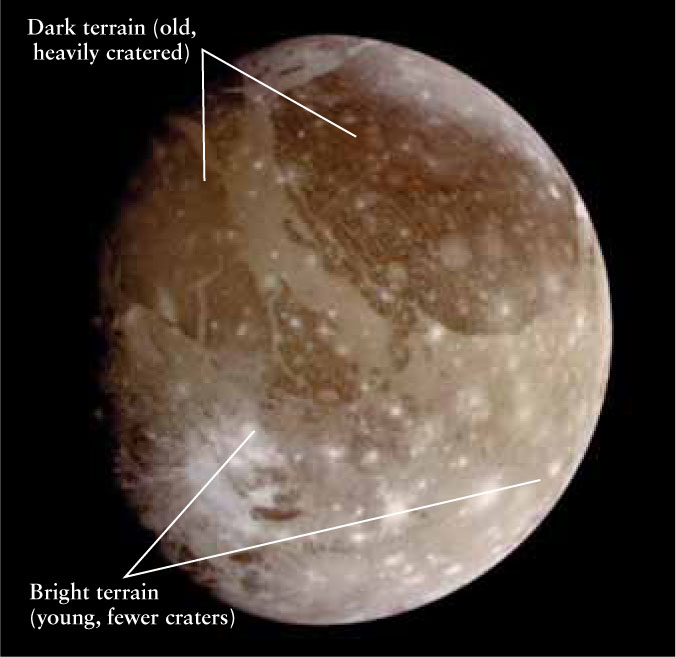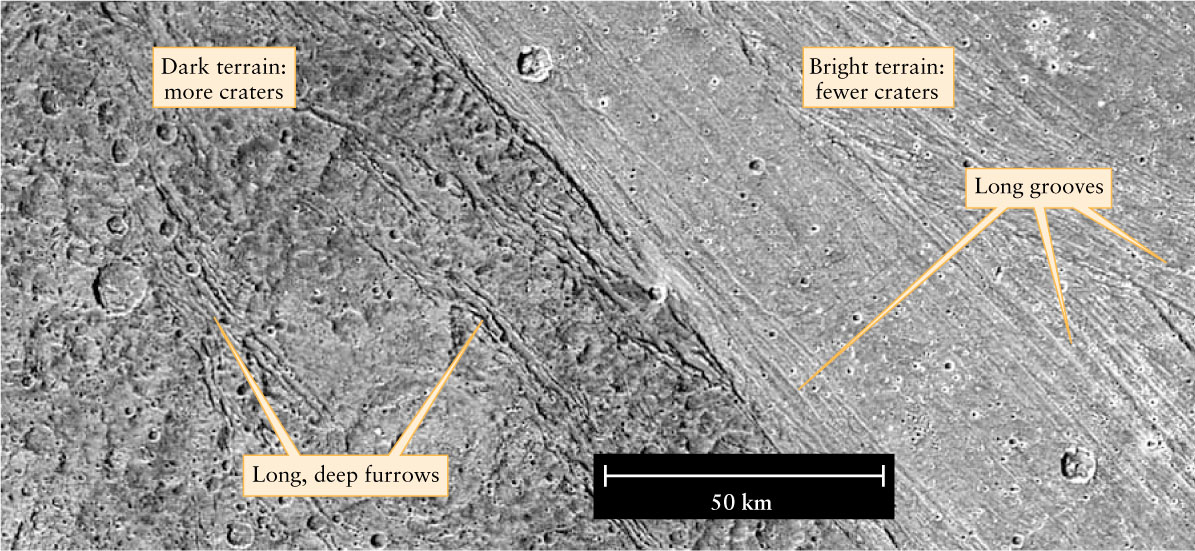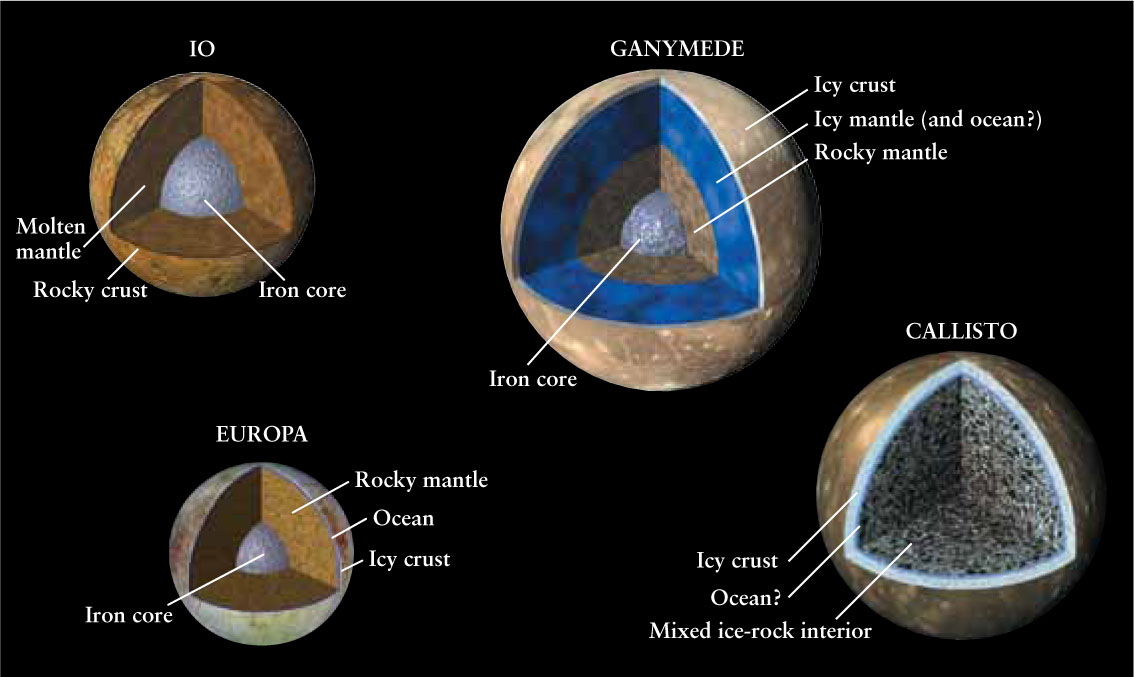13-7 Liquid water may also lie beneath the cratered surfaces of Ganymede and Callisto
Both Ganymede and Callisto show evidence of past geologic activity
Unlike Io and Europa, the two outer Galilean satellites have cratered surfaces. In this respect, Ganymede and Callisto bear a superficial resemblance to our Moon (see the illustration with Table 13-1). But unlike the Moon’s craters, the craters on both Ganymede and Callisto are made primarily of ice rather than rock, and Ganymede has a number of surface features that indicate a geologically active past.
The Two Faces of Ganymede’s Surface

Ganymede Two distinct types of terrain—one dark, heavily cratered, and hence old, the other bright, less cratered, and hence younger—are visible in this Galileo image of the hemisphere of Ganymede that always faces away from Jupiter. Craters in general appear bright, suggesting that the impacts that formed the craters excavated the surface to reveal ice underneath.
Ganymede is the largest satellite in our solar system and is even larger than the planet Mercury. Like our Moon, Ganymede has two distinct kinds of terrain, called dark terrain and bright terrain (Figure 13-15). On the Moon, the dark maria are younger than the light-colored lunar highlands (see Section 10-1). On Ganymede, by contrast, the dark terrain is older, as indicated by its higher density of craters. The bright terrain is much less cratered and therefore younger. Because ice is more reflective than rock, even Ganymede’s dark terrain is substantially brighter than the lunar surface.
Voyager and Galileo images show noticeable differences between young and old impact craters on Ganymede. The youngest craters are surrounded by bright rays of freshly exposed ice that has been excavated by the impact (see the lower left of Figure 13-15). Older craters are darker, perhaps because of chemical processes triggered by exposure to sunlight.
The close-up Galileo image in Figure 13-16 shows the contrast between dark and bright terrain. The area on the left-hand side of this image is strewn with large and small craters, reinforcing the idea that the dark terrain is billions of years old. The dark terrain is also marked by long, deep furrows, which are deformations of Ganymede’s crust that have partially erased some of the oldest craters. Since other craters lie on top of the furrows, the stresses that created the furrows must have occurred long ago. Since geologic activity is a result of a planet or satellite’s internal heat, this shows that Ganymede must have had a warm interior in the distant past.

Evidence for Geologic Activity on Ganymede Stresses in Ganymede’s crust have produced linear features that extend for hundreds of kilometers across both the dark and bright terrain. These features must be quite ancient, since numerous impact craters have formed on top of them.
Linear features are also seen in the bright terrain on the right in Figure 13-16. The Voyager missions discovered that the bright terrain is marked by long grooves, some of which extend for hundreds of kilometers and are as much as a kilometer deep. Images from Galileo show that some adjacent grooves run in different directions, indicating that the bright terrain has been subjected to a variety of tectonic stresses. Galileo also found a number of small craters overlying the grooves, some of which are visible in Figure 13-16. The density of craters shows that the bright terrain, while younger than the dark terrain, is at least a billion years old.
After the Voyager missions, it was thought that the bright terrain represented fresh ice that had flooded through cracks in Ganymede’s crust, analogous to the maria on our Moon (see Section 10-1). However, high-resolution Galileo images do not show the kinds of surface features that would be expected if this terrain were produced by ice-volcanoes. Yet there are several low-lying areas within the bright terrain that appear to have been flooded by a watery fluid that subsequently froze. These low-lying areas may be rift valleys where the crust has been pulled apart, like Valles Marineris on Mars (see Section 11-5). In order to flood the floors of these valleys, there must have been liquid water beneath Ganymede’s surface when the valleys formed. This is additional evidence that Ganymede must have had a warm interior in the past, and that this internal warmth persisted at least until the era when the bright terrain formed a billion years ago. The persistence of internal warmth is rather surprising, because Ganymede is too small to have retained much of the heat left over from its formation or from radioactive elements, and it orbits too far from Jupiter to have any substantial tidal heating.
Ganymede’s Interior and Bizarre Magnetic Field
An equally great surprise from Galileo observations was the discovery that Ganymede has its own magnetic field, and that this field is twice as strong as that of Mercury. This field is sufficiently strong to trap charged particles, giving Ganymede its own “mini-magnetosphere” within Jupiter’s much larger magnetosphere. The presence of a magnetic field shows that electrically conducting material must be in motion within Ganymede to act as a dynamo, which means that the satellite must have substantial internal heat even today. A warm interior causes differentiation, and Galileo measurements indeed showed that Ganymede is highly differentiated. It has a metallic core some 500 km in radius, surrounded by a rocky mantle and by an outer shell of ice 800 km thick.
An even more surprising result is that Ganymede’s magnetic field varies somewhat as it orbits Jupiter, and that these variations are correlated with Ganymede’s location within Jupiter’s magnetic field. One explanation for this variation is that Ganymede has a layer of salty, electrically conducting liquid water some 170 km beneath its surface. As the satellite moves through Jupiter’s magnetic field, electric currents are induced in this layer just as happens within Europa (see Section 13-6), and these currents generate a weak field that adds to the stronger field produced by Ganymede’s dynamo.
A possible explanation for Ganymede’s internal heat is that gravitational forces from the other Galilean satellites may have affected its orbit. While Ganymede’s present-day orbit around Jupiter is quite circular, calculations show that the orbit could have been more elliptical in the past. Just as for Io and Europa, such an elliptical orbit would have given rise to substantial tidal heating of Ganymede’s interior. It may have retained a substantial amount of that heat down to the present day.
Callisto’s Perplexing Surface
In marked contrast to Io, Europa, and Ganymede is Callisto, Jupiter’s outermost Galilean satellite. Images from Voyager showed that Callisto has numerous impact craters scattered over an icy crust (Figure 13-17). Callisto’s ice is not as reflective as that on Europa or Ganymede, however; the surface appears to be covered with some sort of dark mineral deposit.

Callisto Numerous craters pockmark Callisto’s icy surface. The inset shows a portion of a huge impact basin called Valhalla. Most of the very smallest craters in this close-up view have been completely obliterated, and the terrain between the craters is blanketed by dark, dusty material.
CAUTION!
Figure 13-17, as well as the images that accompany Table 13-1, shows that Callisto is the darkest of the Galilean satellites. Nonetheless, its surface is actually more than twice as reflective as that of our own Moon. Callisto’s surface may be made of “dirty” ice, but even dirty ice reflects more light than the gray rock found on the Moon. If you could somehow replace our Moon with Callisto, a full moon as seen from Earth would be 4 times brighter than it is now (thanks also in part to Callisto’s larger size).
The Voyager images led scientists to conclude that Callisto is a dead world, with an ancient surface that has never been reshaped by geologic processes. There is no simple relationship between Callisto’s orbital period and those of the other Galilean satellites, so it would seem that Callisto never experienced any tidal heating and hence was unable to power any geologic processes at its surface. But once the Galileo spacecraft went into orbit around Jupiter and began returning high-resolution images, scientists realized that Callisto’s nature is not so simple. In fact, Callisto proves to be the most perplexing of the Galilean satellites.
One curious discovery from Galileo is that while Callisto has numerous large craters, there are very few with diameters less than 1 km. Such small craters are abundant on Ganymede, which has probably had the same impact history as Callisto. The lack of small craters on Callisto implies that most of these craters have been eroded away. How this erosion could have happened is not known. Another surprising result is that Callisto’s surface is covered by a blanket of dark, dusty material (see the inset in Figure 13-17). Where this material came from, and how it came to be distributed across the satellite’s surface, is not understood.
Callisto’s Interior: Hot or Cold?
Callisto’s most unexpected feature is that, like Europa and Ganymede, it appears to have an induced magnetic field that varies as the satellite moves through different parts of Jupiter’s magnetosphere. Callisto must have a layer of electrically conducting material in order to generate such a field. One model suggests that this material is in the form of a subsurface ocean like Europa’s but only about 10 km (6 mi) deep. However, without tidal heating, Callisto’s interior is probably so cold that a layer of liquid water would quickly freeze. One proposed explanation is that Callisto’s ocean is a mixture of water and a form of “antifreeze.” In cold climates on Earth, antifreeze is added to the coolant in automobile radiators to lower the liquid’s freezing temperature and prevent it from solidifying. Ammonia (NH3) in Callisto’s proposed subsurface ocean could play the same role: There was plenty of ammonia available at these far reaches of the solar system, and the ability for ammonia to act like an antifreeze is well-established.
The presence of a liquid layer beneath Callisto’s surface is difficult to understand. Even with ammonia acting as an antifreeze, this layer cannot be too cold or it would solidify. This argues for a relatively warm interior. But Galileo measurements suggest that Callisto’s interior is not highly differentiated. The lack of differentiation implies that the interior is cold, and may never have been heated enough to undergo complete chemical differentiation. The full story of Callisto’s interior, it would seem, has yet to be told.
Although Ganymede and Callisto have many differences, one feature they share is an extremely thin and tenuous atmosphere. Like Europa, Ganymede has a thin oxygen (O2) atmosphere thought to be created when radiation splits water-ice (H2O) on the surface into oxygen and hydrogen, with the lighter H2 escaping Ganymede’s weak gravity. On Callisto, the atmosphere is known to contain carbon dioxide (CO2). This gas would escape in several days and is thought to be replenished by evaporation of CO2 ice from Callisto’s cold polar regions.
The diagrams in Figure 13-18 summarize the probable interior structures of the Galilean satellites. They demonstrate the remarkable variety of these terrestrial worlds.

CONCEPT CHECK 13-8
Why is it thought that Callisto contains ammonia?
Callisto has an unexpected induced magnetic field: unexpected because this indicates a liquid ocean, yet at Callisto’s temperature any interior water should be frozen. However, ammonia allows water to remain a liquid at temperatures where pure water would freeze.